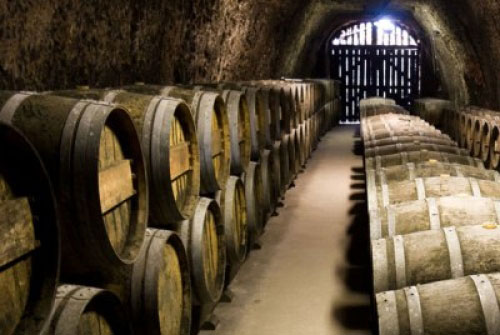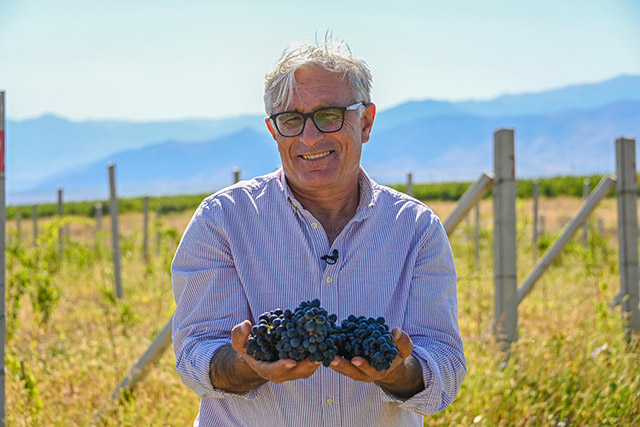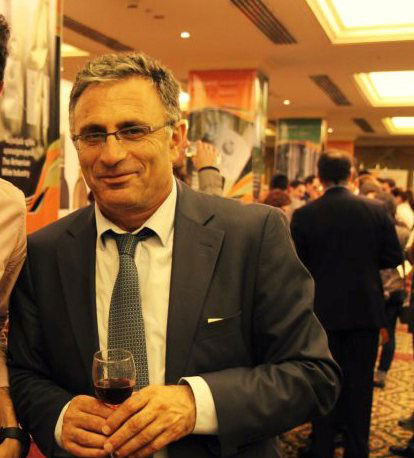Our neighboring country Georgia’s economic development relies on tourism and wine production. The Georgian government has declared these 2 spheres as priority industry and spares no resources for the development of these industries. Georgians so impressively and convincingly advertize the high quality of their wines that every tourist visiting Georgia does not leave the country without being loaded with a dozen of bottles of Georgian wines. Recently, the National Tourism Administration of Georgia invited great groups of journalists from Armenia, Ukraine, Belarus, Kyrgyzstan, Azerbaijan and Kazakhstan for a media-tour and to get acquainted with Georgian winemaking.
Prior to taking the journalists of aforesaid countries to visit the places of sightseeing of Georgia, the National Tourism Administration of Georgia organized a meeting with the President of Sommelie Association of Georgia Shalva Khetsuriani. Georgians call him the wine ambassador. Khetsuriani proudly announced that Georgia is the cradle of wine. He also joked saying, “Of course, the Armenians will say that it is a lie, and Armenia is the wine homeland.” “Certainly, Armenians can claim and prove that the wine production originated in Armenia”, said the President of Union of Winemakers Avag Harutyunyan in the conversation with “Aravot”. However, Georgia’s wine ambassador presented some historical episodes to the foreign journalists, as a result, apart from Armenians, the journalists from other countries left this country with a belief that Georgia is the wine homeland (hardly the Belarus or Kyrgyz would search in the scientific literature to find out who the oldest viticulturist is).
Shalva Khetsuriani assured that winemaking in Georgia has a history of 8000 years, the archeologists have discovered an 8,000-year old grape stones and that much grape clusters in South Georgia. “The next main hero is the clay jar, in which the Georgians kept grain and wine. These are a few facts that viticulture was born in Georgia.” In the conversation with us, Avag Harutyunyan countered that talking about 8000 years of history of Georgian winemaking is at least ridiculous, winemaking refers to the universal history, because there were neither Armenians nor Georgians 8000 years ago, the ethnicities were not formed, they were formed since 3-4th Millennium B.C or since 2-3rd. “Discovering a grape stones or cluster yet does not mean that the winemaking was in that era. We have solid evidence that speaks to which country the oldest samples appeared, but it has nothing to do with the country’s history. The grape stones are found in Shulaver village. This village originally since the formation of Ethnos was Armenians, it was resided by Armenians and the Armenian ancestors have made the wild grapes cultivated and received wine from it. Grape stones were discovered in the Armenian highlands that are 500-1000 years older than the Georgian grape stones.”
Mr. Harutyunyan reminded the winery found in the Areni cave. “It is one thing when an old charred grape-stone is discovered, and another thing when a whole plant is discovered with its equipment preserved. The upper layers of Areni cave go back to the year of 6100, while the bottom layers are older. Even the Jews have admitted that Armenia is the wine homeland, referring to Noah and winemaking in the Old Testament.” Armenia being a wine country, however, winemaking in Georgia is more widespread and more sophisticated. According to the words of the Georgian wine ambassador, almost every Georgian family, even the urban residents make wine in their garages and quite successful. Wine is always present at the Georgian table, and the government spends huge amounts of money, even received grants from the European Union for winemaking and spreading and recognizing Georgian wine worldwide. As presented by Khetsuriani, there are about 150 wine producing workshop in Georgia, today, it is impossible to simulate the Georgian wine and to introduce the low-quality wine under high quality, assured the wine ambassador. All workshops are strictly controlled. “Georgian wine is good and well-made.”
Read also
Currently, Georgia exports 59 million bottles of wine, Armenia is falling behind by these numbers. Our government does not pay too much attention to the Armenian wine-makers, more emphasis is laid on brandy production. Avag Harutyunyan assured that although today we produce 5-6 million bottles of wine, anyway, the potential of the Armenia wine is infinite, we can produce 15-20 million bottles in 4 years. The export volume of our wine is 1.5 million bottles. Mr. Harutyunyan noted that the government should pay much attention to winemaking, one liter of cognac is received from 14-15kg of grapes and one liter of wine from 2 kg of grapes. “The revenue from one bottle of wine is as much as from one bottle of cognac. Producing wine is more profitable. If the wine production is reached, let’s say, up to 17 million bottles, then the revenue will be more than 40 million bottles of cognacs. This does not mean that we should give up the cognac, we have very good cognacs, let them move forward, we just have to give up the cognac as an idea of universal product. Today, the wine of 4-5 winemakers does not yield the Georgian wine; there are even better ones. Simple presenting the Armenian wine to the world is expensive. Last time I was in Dusseldorf, the world most popular exhibit of wine is here. Armenia was never able to attend it, it was ever expensive, this year the government and another international organization supported, and 5 Armenian companies were able to attend. This is very important for us, at least Armenia became known, many people were approaching with questions of where Armenia is, whether it is close to Romania, whether we are Muslims, and how we make wine.”
Mr. Harutyunyan said that 4 annual wine exhibition of international significance is held in the world, which requires 30-40 thousand euros to attend each exhibition, while the producers and the government are unable to invest this amount of money for the Armenia to attend each time, whereas Georgia spends 200 thousand euros per year to attend these exhibitions. “If our government finds money for the winemakers, the world will perceive Armenia much better. On the other hand, the excise tax bothers us. Georgia being a powerful winemaking country has waived the excise tax since 2006, while we are asking for a long time to at least reduce this tax type.”
Nelly BABAYAN


























































